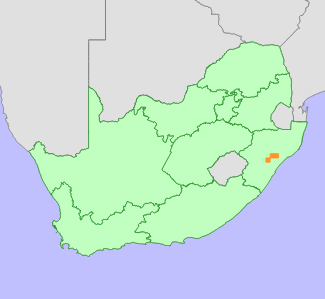|
Scientific Name | Syncolostemon latidens (N.E.Br.) Codd |
Higher Classification | Dicotyledons |
Family | LAMIACEAE |
Synonyms | Hemizygia latidens (N.E.Br.) M.Ashby, Orthosiphon latidens N.E.Br. |
National Status |
Status and Criteria | Vulnerable B1ab(ii,iii,iv,v)+2ab(ii,iii,iv,v) |
Assessment Date | 2007/05/17 |
Assessor(s) | C.R. Scott-Shaw, I.M. Johnson, D. Raimondo & L. von Staden |
Justification | EOO 730 km², and due to its habitat specificity, AOO is estimated to be <20 km². Seven known locations are declining due to ongoing habitat loss, mainly due to expanding forestry plantations and alien plant invasion. |
Distribution |
Endemism | South African endemic |
Provincial distribution | KwaZulu-Natal |
Range | Greytown to Kranskop. |
Habitat and Ecology |
Major system | Terrestrial |
Major habitats | Eastern Valley Bushveld, Thukela Valley Bushveld, Midlands Mistbelt Grassland |
Description | Rocky grasslands, where grasslands border with thornveld or forest, 900-1100 m. |
Threats |
| Threatened on the eastern edge of the range by conversion of habitat to forestry plantations. The Tugela catchment has not yet been closed to further afforestation and there are many areas being converted on an ongoing basis (C.R. Scott-Shaw pers. comm. 2007).
There are also an increasing number of subsistence farmers moving up the valleys below Kranskop to the higher lying areas where this species grows. The spread of farming communities leads to increased grazing pressure as well as pressure on natural resources such as firewood harvesting and increased fire frequencies are likely to impact on the forest/woodland margins where this species grows (I. Johnson, pers. comm.).
Invasions by Lantana and Chromolaena have already taken over much of the habitat along the road to Nadi. These invasives are presumably spread by cattle, and with increased numbers of livestock moving in, the problems with exotic invasions are likely to increase in future (I. Johnson pers. comm.).
Around Greytown populations are potentially threatened by habitat degradation, invasion by alien exotics and urban spread. |
Population |
Population trend | Decreasing |
Assessment History |
Taxon assessed |
Status and Criteria |
Citation/Red List version | | Syncolostemon latidens (N.E.Br.) Codd | VU B1ab(ii,iii,iv,v)+2ab(ii,iii,iv,v) | Raimondo et al. (2009) | | Syncolostemon latidens (N.E.Br.) Codd | VU | Scott-Shaw (1999) | |
Bibliography |
Codd, L.E. 1976. The genus Syncolostemon (Lamiaceae). Bothalia 12(1):21-27.
Raimondo, D., von Staden, L., Foden, W., Victor, J.E., Helme, N.A., Turner, R.C., Kamundi, D.A. and Manyama, P.A. 2009. Red List of South African Plants. Strelitzia 25. South African National Biodiversity Institute, Pretoria.
Scott-Shaw, C.R. 1999. Rare and threatened plants of KwaZulu-Natal and neighbouring regions. KwaZulu-Natal Nature Conservation Service, Pietermaritzburg.
|
Citation |
| Scott-Shaw, C.R., Johnson, I.M., Raimondo, D. & von Staden, L. 2007. Syncolostemon latidens (N.E.Br.) Codd. National Assessment: Red List of South African Plants version . Accessed on 2025/05/31 |
 Comment on this assessment
Comment on this assessment


